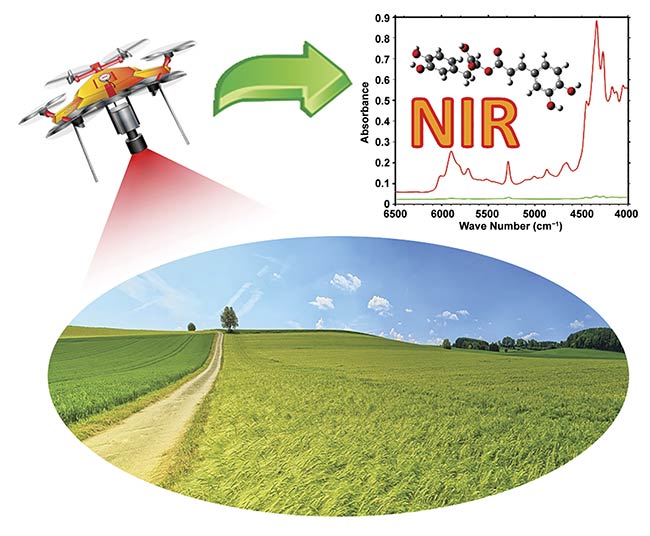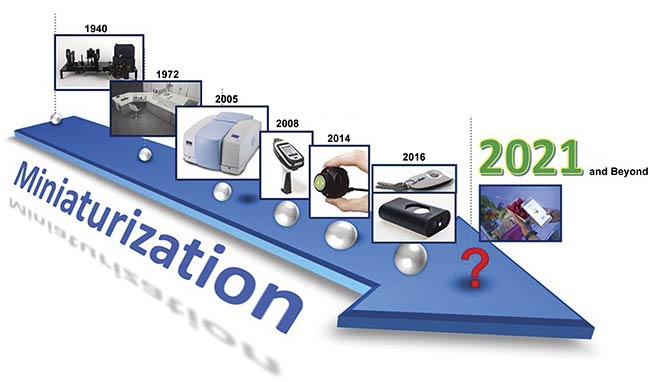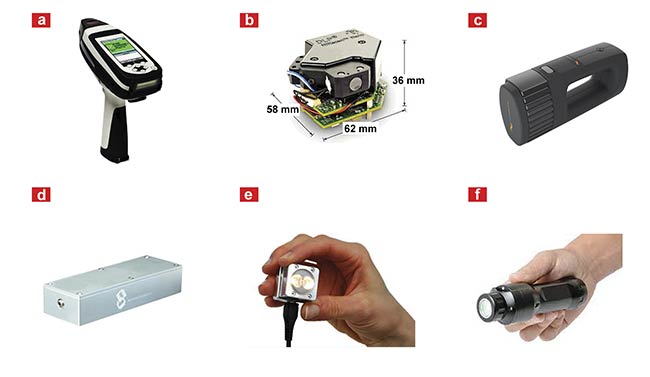Smartphone-based sensor technology, in conjunction with chemometrics and machine learning, is advancing applications such as agricultural and environmental field monitoring.
KRZYSZTOF B. BEC AND CHRISTIAN W. HUCK, UNIVERSITY OF INNSBRUCK
Near-infrared (NIR) spectroscopy has been used in groundbreaking research in many of the life sciences1 due to its capacity to rapidly determine and analyze the composition of materials. Bulky instruments with limited portability, however, have kept the technology from being used in field applications. Current trends in miniaturization, however, have opened up new realms in which NIR spectroscopy would never have functioned years ago, providing on-site, flexible, and accurate tools for agricultural and environmental analysis and food quality inspection. This is especially true in the herbal medicine and food industries, where smartphone-operated sensors can be easily used in remote locations for rapid on-site analysis — for example, for in-field monitoring of medicinal plants.

Drone-mounted NIR spectroscopy enables remote sensing of large areas of Earth’s surface in service of precision agriculture and environmental monitoring. Courtesy of the University of Innsbruck.
A Short Course on NIR Spectroscopy
During Pittcon 2022, which runs March 5 to 9 in Atlanta, the authors will offer a short course titled “A Guide to Near-Infrared (NIR) Spectroscopy: From Physical Principles to Diversity of Applications.” The course will give particular attention to the intriguing interconnections between the physicochemical background, instrumental factors, data analytics methods, and the wide spectrum of applications of NIR spectroscopy.
Theoretical simulation of NIR spectra has decisively shifted the limits of the spectral data interpretability that was a limitation of this technique. When spectral data is combined with chemometrics and machine learning, optimization of the sensor suite for specific applications becomes easier than ever before. Current developments in multisensor designs enable data fusion that integrates information provided by NIR spectroscopy with that of other complementary techniques. Nowadays — in applications from precision agriculture and quality control of foodstuff to on-line industrial applications, to environmental monitoring and wearable medical sensors — NIR spectroscopy is providing substantial aid in meeting contemporary challenges in health and quality control2.
Contemporary NIR spectroscopy
The ability to rapidly analyze several properties of a sample at once is an advantage that NIR spectroscopy shares with other techniques. However, NIR spectroscopy combines this multifaceted analysis with the ability to evaluate molecular composition of the sample noninvasively and in bulk, without prior preparation, such as dilution or deposition, in a nonabsorbing agent. This marks a clear distinction between NIR spectroscopy and its nearest peer on the spectrum, mid-infrared (MIR) spectroscopy, which requires problematic attenuated total reflection for bulk analysis.
Consequently, NIR spectroscopy offers unmatched capacity to perform rapid quantitative compositional analysis of a wide variety of samples, ranging from relatively simple and uniform industrial materials to the immensely complex natural matrices that are common in agri-food products.
History of NIR spectroscopy
In the early years of the development and testing of vibrational spectroscopy (in the first half of the 20th century), researchers operated primarily in the MIR region. NIR spectroscopy was underestimated for at least two distinct reasons. First, the very nature of molecular vibrations had not yet been extensively explored, and use of the less-complex data provided by MIR spectra, where bands could be identified in isolation of others, was preferred.
Second, many researchers believed no useful data was to be found in the NIR region. Engineer Karl Norris was the one who recognized the analytical potential of NIR spectroscopy. Norris’ early work applied the technique to the identification of analytes in agricultural products. In the era preceding digital electronics or Fourier transform spectrometers, the skepticism of the scientific community was difficult to overcome. Nonetheless, NIR spectroscopy proved to be a potent and flexible tool.
Sensor miniaturization
One of the most effective breakthroughs that paved the way for new applications in NIR spectroscopy was the miniaturization of spectroscopic instruments (Figure 1). While the trend is common in spectroscopy and spectrometry overall, in the case of the NIR technique, miniaturization and the cost-effectiveness of the instruments form a particular synergy with the devices’ functionality. Optical materials, fibers, light sources, and even detectors — if the long-wavelength fragment of the spectrum is taken into consideration — work especially well for constructing inexpensive, miniaturized devices3. And rugged spectrometers are better able to send and receive energy in the NIR region than instruments used in MIR or Raman spectroscopy. Other cost-efficient techniques, such as fluorescence, also cannot match the chemical specificity or wide applicability of NIR spectroscopy. With NIR spectrometers, rapid, flexible, high-throughput qualitative and quantitative analysis can be performed on-site with superior efficiency.
The past decade has witnessed the steady reduction in the size of portable NIR sensors that are used in a number of different instruments (Figure 2). Some of the first hand-held designs that were introduced commercially weighed over
1 kg, although admittedly they functioned as autonomous units with their own displays and user interfaces. Subsequent generations of spectrometers have been far more compact, weighing well below 50 g. They have relied on a wired USB or wireless Bluetooth connection and an application installed on the user’s device (such as a smartphone or tablet PC) for remote control operation3. Integration of even more compact NIR spectrometers within the housing of smartphones and wearables is currently being developed by several technology giants. These producers have recognized the potential of offering a molecular analysis device to the general public.

Figure 1. Progressive miniaturization of sensors has revolutionized NIR spectroscopy over the past decade by enabling a set of new applications. Courtesy of the University of Innsbruck.

Figure 2. Popular miniaturized NIR spectrometers representing various optical concepts, engineering solutions, and levels of miniaturization: Thermo Fisher Scientific’s MicroPHAZIR (a), Texas Instruments’ DLP NIRscan Nano EVM (b), Si-Ware Systems’ NeoSpectra (c), Hefei SouthNest Technology’s nanoFTIR NIR (d), Spectral Engines’ NIRONE Sensor S (e), and VIAVI Solution’s MicroNIR 1700ES (f). Adapted with permission from Reference 2/CC BY 4.0.

Figure 3. Sensor fusion design: a schematic of a flow cell combining
absorbance (UV-VIS and NIR) and Raman spectroscopy to monitor a process stream for multiple analytes (top). Example spectral output from the product stream over the course of a single processing run (a-f) showing overlay (bottom left) and shown as a function of time (bottom right). Pu: plutonium; Np: neptunium. Adapted with permission from Reference 5. Courtesy of the American Chemical Society.
Typically, miniaturization does have an impact on a sensor’s performance. Furthermore, in contrast to benchtop NIR spectrometers (Fourier transform-based), several distinct optical principles proved to be challenging in the realm of miniaturized instruments. Therefore, researchers have directed much of their attention toward systematic evaluations of the analytical performance of sensors in various scenarios.
Airborne NIR spectrometers
Significant advancements in the technology required for airborne NIR spectroscopy have been seen in the past decade, representing the cutting edge in sensor development. Airborne applications are at the junction point of developments in miniaturization, power efficiency, and advanced spectral data processing.
NIR spectrometers are particularly well suited to be integrated with unmanned aerial vehicles (UAVs). Drone spectroscopy, an important division of remote sensing, provides unprecedented opportunities for agricultural and environmental analysis due to its capacity for high-throughput sensing of large areas of Earth’s surface (see first image in article: Drone-mounted NIR spectroscopy).
In UAV NIR spectroscopy, the technology has progressed in conjunction with data analytics approaches. New sets of problems have been identified in airborne spectroscopy that many scientists and engineers thought had been solved during the development of earlier renditions of the technology. For instance, background reflectance variations or atmospheric effects can significantly interfere with the measured spectra. Solving such problems often requires original solutions — for instance, smart flight planning that takes into account sun position and surface topology. Further, large data volumes create computationally intensive problems, emphasizing the need to integrate smart data analytics frameworks for sensors used in airborne applications.
Sensor data fusion
Cost-efficient, miniaturized NIR sensors are particularly well suited for integration into multiband spectrometers. Sensor fusion is being utilized in a variety of fields. Figure 3 shows examples of potential industrial applications of fused NIR, UV-VIS, and Raman sensors for on-line simultaneous monitoring of several chemical components. In such a suite, NIR spectroscopy’s correlative character-enhancing chemical fingerprinting becomes apparent. NIR, MIR, and Raman spectroscopy are complementary techniques, and their combined use can provide more information than each method can when used separately.
In other potential applications of sensor fusion, the physical attributes of NIR light can be highly useful. For example, deep penetration of the NIR wavelengths beneath the surface of a sample can provide information about its interior, while other sensors may generate only surface-
constrained data. This ability of NIR sensors was recognized early on, and in fact led to the adoption of NIR spectroscopy in medical applications. Brain activity monitoring and noninvasive blood analysis via the skin are two procedures for which the use of a technique known as functional NIR spectroscopy has become well established in medical diagnostics2.
Advanced spectral analysis
Since its infancy, NIR spectroscopy has strongly relied on data analytics tools to extract valuable information from the examined object and correlate it with a given property of interest. Chemometrics provides some aid in the analysis used in various areas of chemistry and the life sciences, but it functions especially well in collaboration with NIR spectroscopy. In fact, the roots of multivariate analysis methods are strongly intertwined with this analytical technique, as some regression methods were specifically developed to be used in tandem with NIR spectroscopy.
However, the intrinsic complexity of NIR spectra has always been a hindrance for their direct interpretation. This limitation in the molecular fingerprinting ability of NIR spectroscopy — as compared to Fourier transform-IR and Raman techniques, which have strong fingerprinting abilities — could be preventing wider use of the technique in certain applications, including in the biomedical space. However, in recent years decisive progress in the applications of computational chemistry have addressed this shortcoming1,4, enabling a very detailed dissection of NIR spectra while also unveiling the intrinsically convoluted nature of NIR spectra in an illustrative way (Figure 4).

Figure 4. Vibrational contributions from overtones and combination bands to the NIR spectrum of a piperine molecule (left). The application of this information for the interpretation of the instrumental difference can be seen in the calibration models (right) trained for the benchtop Büchi NIRFlex N-500 (a) and the miniaturized microPHAZIR spectrometer (b). Adapted with permission from Reference 6/CC BY 4.0.
In addition to improving the interpretability of NIR spectra, the information provided by spectra simulation can be helpful in solving various problems in analytical scenarios. For example, understanding the variables in chemometric models could elucidate the chemical contribution to the differences that are observed in the performance of various NIR spectrometers, especially the miniaturized ones. This information could yield a better-informed choice of sensor, based on the parameters of the intended analysis.
Emerging applications
The spectrum of NIR spectroscopy applications is remarkably wide. Various industries value this technique for its capability to monitor a variety of samples, on-site and on-line. In this context, sensor miniaturization provides increased flexibility, regardless of the application. For example, hand-held spectrometers are used in the herbal medicine industry for monitoring plant conditions. Rapid analysis of a plant’s therapeutic agent, performed directly in the field, allows the plant to be harvested at the optimal time for medicinal use2.
In agriculture, miniaturized NIR spectrometers that are integrated with advanced suites of data analytics tools — for example, pre-calibrated models and cloud service — are offered to farmers as customized analyzers. These packages are designed to be easily used without the need for sophisticated training, and the results of the analysis are processed without the need for the user to directly input specific information — for example, any reference data. Airborne, UAV-mounted spectrometers also provide monitoring of crop and soil conditions over large areas and can help to maintain the quality of agricultural products. While this technology has not yet reached maturity, it is undergoing dynamic development and has great potential to become a mainstay in the agricultural workflow of the future. Airborne spectroscopy offers similar advantages in environmental monitoring, as vegetation is a sensitive marker of environmental conditions.
Portable, easy-to-use NIR spectrometers are also used to screen foodstuffs for quality, authenticity, freshness, presence of contaminants, and undesired adulterants. Some instruments are oriented to consumers who can benefit from having a food analyzer in their pocket. Early generations of such devices were met with criticism because of the design compromises made in order to bring the device’s unit price to a level acceptable to customers. However, rapid progress in the technology should make these analyzers more robust in the near future.
Finally, in the health care domain, wearable NIR sensors, which are under continued intensive development, have enabled patients to enjoy daily life while undergoing continuous monitoring of essential health parameters. These wearables include, for example, headbands that measure brain activity and wristbands that monitor glucose in the blood. Such analyses are nothing new, as both are the most canonical medical applications of NIR spectroscopy. However, before the technology was wearable, patients had to go to the hospital for diagnosis, and sometimes they needed to stay there for a long time. Wearables enable continuous analysis to be performed without affecting patients’ daily lives.
Meet the authors
Krzysztof B. Bec is a senior research fellow and project leader on Christian W. Huck’s research team at the University of Innsbruck in Austria. Bec’s background is in physical and theoretical chemistry, and his experience in developing new methods of NIR spectroscopy gives him a unique perspective on the technology; e-mail: [email protected].
Christian W. Huck is vice-head of the Institute of Analytical Chemistry and Radiochemistry at the University of Innsbruck. He works with Austrian and German industry to actively develop new applications for vibrational spectroscopy, with a focus on portable instruments; email: [email protected].
References
1. K.B. Bec and C.W. Huck (2019). Breakthrough potential in near-infrared spectroscopy: spectra simulation. A review of recent developments. Front Chem, Vol. 7, p. 48.
2. K.B. Bec et al. (2020). Near-infrared spectroscopy in bio-applications. Molecules,
Vol. 25, p. 2948.
3. K.B. Bec et al. (2020). Handheld near-infrared spectrometers: where are we heading? NIR News, Vol. 31, pp. 28-35.
4. Y. Ozaki et al. (2021). Advances, challenges and perspectives of quantum chemical approaches in molecular spectroscopy of the condensed phase. Chem Soc Rev, Vol. 50, pp. 10917-10954.
5. A.M. Lines et al. (2020). Sensor fusion: comprehensive real-time, on-line monitoring for process control via visible, near-infrared, and Raman spectroscopy, ACS Sens, Vol. 5, pp. 2467-2475.
6. J. Grabska et al. (2021). Theoretical simulation of near-infrared spectrum of piperine: insight into band origins and the features of regression models. Appl Spectrosc, Vol. 75, pp. 1022-1032.